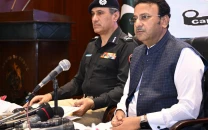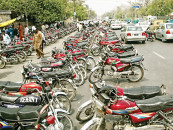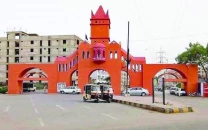Revival of KCR seems doubtful despite Supreme Court orders
Displacement of settlements built on encroached land is the biggest hurdle in the restoration of KCR

Displacement of settlements built on encroached land is the biggest hurdle in the restoration of KCR. PHOTO: FILE
The 42.3-kilometres-long KCR track is lined with settlements comprising high rises, concrete houses and katchi abadis on both sides, which are built on encroached land. Displacement of these settlements and provision of alternative land for housing to the displaced people is the biggest hurdle in the restoration of KCR. However, achieving it seems an objective too far-fetched, despite the orders issued by the Supreme Court (SC) to evacuate the land along KCR's tracks.
CM Sindh seeks right of way to revive KCR
A two-member bench at SC's Karachi Registry had passed orders for the Pakistan Railways to clear KCR's tracks of encroachments within 15 days and restore its operation within a month, last Thursday.
The SC also directed the Pakistan Railways to seek help from the Karachi mayor and other authorities for the evacuation of land, adding that it may even consider taking assistance from armed forces and Rangers, in case it faced resistance from the public.
However, there seems to be a lack of will among political parties and provincial and federal government to carry out these orders.
Vote banks
Settlements along both sides of the KCR's tracks, extending from Wazir Mansion to Malir Halt and Liaquatabad to SITE area, account for a huge vote bank for various political parties. Displacing residents from these settlements would be akin to losing out on a large number of votes.
Henceforth, Pakistan Tehreek-e-Insaf and Muttahida Quami Movement-Pakistan are resisting the evacuation of the railway land in District South and in Liaquatabad, Nazimabad and Gulshan-e-Iqbal, respectively. Both parties demand the allocation of alternative land for the resettlement of the evacuees prior to their displacement in order to secure their vote banks.
Meanwhile, the Sindh Government appears hesitant to fulfil its responsibility of evacuating the KCR's tracks and resettling the displaced.
Not only doe it fear public retaliation following the demolition of encroachments, it is also unprepared to provide alternative settlements to the prospective evacuees. To begin with, it has not conducted any survey in the area and hence, has no data of the communities settled along the tracks. Without any data of the residents occupying the land, gauging the scale of displacement and accurately calculating the cost of resettlement may prove to be a task near to impossible.
According to a survey conducted by the Japan International Corporation Agency (JICA), around 4,650 families were residing along the tracks of KCR in 2013. This number is likely to be much higher now, which means that the evacuation would result in a considerably larger number of displaced people, making it harder for the government to resettle them without any planning.
The cost
Moreover, even if relevant government bodies manage to comply with the SC's orders, it may still not be enough to restore the operation of KCR. Over the years the cost of the restoration of KCR has increased manifolds, which poses another problem in the way of its revival.
Railway authorities and experts say that the KCR's railway tracks have sunken deep inside the ground and that it would be impossible to run a train on them, citing the installation of new tracks as the only solution.
Additionally, they also point towards the need to construct new junctions and platforms for KCR. The existing junctions cannot be closed due to the heavy traffic flow in the city and a signal free railway track will be needed for the KCR to run, they said, adding that the new track will pass under the ground at some points, which will add to the overall cost of the project.
While on a visit to inspect KCR's tracks in December last year, Pakistan Railways Divisional Superintendent Arshad Islam Khattak had also pointed out the need for new tracks, while talking to the media. These tracks are not efficient enough anymore and an entirely new track needs to be laid out for KCR, he had said.
Further explaining the plan for the new KCR track, he had said that flyovers need to be built at 29 railway crossings along the track, which will make it impossible to complete the construction work before three years.
Considering these technicalities, it would not be possible to restore the operation of KCR within a month's time, as ordered by the SC.
However, the Federal Railways Minister Sheikh Rasheed held the Government of Sindh responsible for the delay in the revival of the railway track during his recent visit to Karachi. He said that the provision of investment for the revival of KCR tracks is not a big issue as this project is approved to be financed under CPEC.
Additionally, Japan Ambassador to Pakistan Kuninori Matsuda had also said during an informal conversation with the media at the Karachi Press Club last month that JICA had prepared a detailed feasibility plan for KCR and offered the financial cooperation for its implementation on the request of the Government of Pakistan in 2007. "However we haven't received any response since then," he said, adding that the offer for cooperating in KCR's revival still stands.
Published in The Express Tribune, May 14th, 2019.



















COMMENTS
Comments are moderated and generally will be posted if they are on-topic and not abusive.
For more information, please see our Comments FAQ